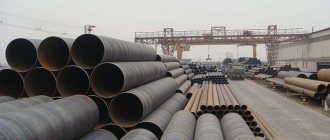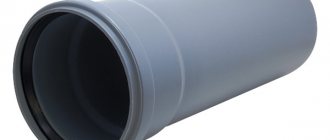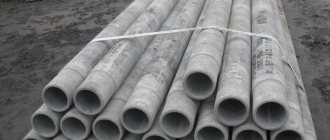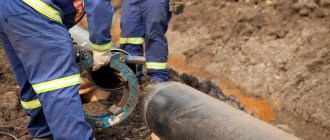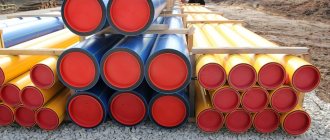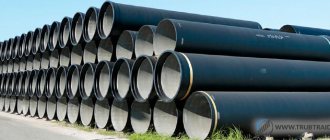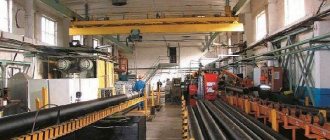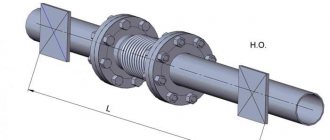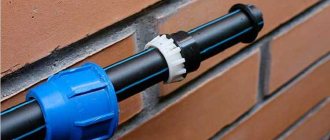Ductile iron pipes are the optimal choice for installing water supply and sewer systems. For manufacturing, special high-strength cast iron with nodular graphite is used (hence the abbreviation VChShG). A cement-sand coating is applied inside the products. Such parts differ in performance characteristics for the better compared to both conventional cast iron (gray cast iron) and steel.
Pipes made of high-strength cast iron have high performance characteristics, are durable and easy to process
ChK pipes
ChK cast iron sewer pipes are used in the construction of modern heating systems, water supply systems and systems for disposing of household and fecal wastewater - both residential and industrial buildings (sewerage).
SML pipe
provides its customers with a wide selection of products used in plumbing and other industries. You can better familiarize yourself with the assortment on the site page “cast iron pipes price”, which contains complete information about the products, their sizes, prices, quantities. Cast iron pipes are classified into several types. These include VChShG pipe, ChK pipe, ChNR pipe, SML pipe.
Cast iron pipes are popular among consumers due to their advantages compared to pipes made from other materials. These products have a long service life, are quite reliable, and their cost is significantly lower than the price of alternative pipes made of metal-polymers or high-quality alloy steel. Cast iron pipes, the price list of which can be viewed on the company’s website, are incredibly popular. They can be used as sewer pipes and more. They are easy to install on site, and have a large margin of reliability and strength, which is an important condition when operating in extreme conditions.
- An indicator such as tensile strength increases;
- The likelihood of internal stresses is significantly reduced;
- Pipes are easy to process and cut into finished products of the required length.
To additionally protect the inner surface of the pipe from chemical or mechanical influence, an environmentally neutral coating is applied to it. The basis of this layer is epoxy resin, which adds elasticity and smoothness to the inner surface and prevents the formation of sediment and deposits. Thus, the likelihood of stagnation or blockage in the pipe is almost zero. The layer thickness is about 130 µm. The outer surface of the pipe is covered with a layer of red-brown primer. When dry, this type of primer forms a thin (15-20 microns), smooth, even surface. This adds additional strength to the pipe, resistance to environmental influences and temperature fluctuations from -45 to +60 degrees Celsius.
SML sewerage
Cast iron has proven itself as a material and can be used in SML systems (sewage systems for residential, multi-storey, commercial and industrial buildings), which are systems made of cast iron that meet international and European standards. SML pipes meet all the necessary requirements imposed by modern construction. This product has an outer coating of a red-brown primer, and an epoxy layer is applied to the inner layer of the pipe, which is highly resistant to various influences (chemical or mechanical).
- SML pipes do not require additional treatment with fire retardant materials and agents;
- Compared to other types, SML sewerage is lighter, more versatile and easier to assemble due to the fact that, in addition to clamps, it does not require additional fasteners. Socketless joints, butt to joint, provide excellent tightness;
- Anti-corrosion SML pipes ensure a long life of the sewer system without repairs or replacements;
- SML sewerage does not require additional noise reduction systems;
- The technical features of the cast iron from which SML pipes are made allow SML sewerage to be embedded in concrete.
- SML sewerage, when used for a long time, significantly saves money on maintenance and repairs.
Due to the fact that this type of sewerage is distinguished by such high technical characteristics, it is usually carried out in buildings with special requirements for noise levels and fire safety, for example, in hotels, higher educational institutions, airports and train stations, hospitals, supermarkets and other places of large crowds of people.
Installation
A special feature of the installation of ductile iron pipes is the absence of welding processes during operations. All installation work is carried out with ordinary construction tools, without the use of electronic or mechanical equipment.
Assembly from pipes and ductile iron fittings
The material used for processing structures is ethylene-propylene diene monomer. Compressing the metal collar from several ends of the pipe ensures a complete seal. The resulting gain from the addition of installation systems allows you to establish clear control over the flow of partial and internal pressure, and if a problem occurs, quickly eliminate it. The resulting cuffs allow the structure to feel comfortable under severe deformations and ground displacements.
With the help of elastomeric sealing collars, you can achieve even greater strength and flexibility of the pipe. When the structure deforms or the soil moves, this system allows the transported substance to continue moving through the channels, reducing the risk of material loss to a minimum.
An excellent addition is the absence of the need to dig trenches along the transport route, allowing the use of a trenchless transmission system, since the deflection of pipes under severe impact is only 4-5 cm.
Upon completion of the installation process, coaxial joining of the ductile iron pipes takes place. Before operation, a special operation called angular deviation is performed.
Functional features of socket connections
The manufacture of socket joints is carried out with the expectation of achieving complete tightness of the joint by establishing contact pressure between the sealing ring of the structure and the material from which the pipe is made.
Angular deviation values during deformation
Since the ductile iron socket connection is flexible, the connecting pipes can deviate from 2 to 6 degrees Celsius. At the same time, no physical harm is caused to the structure, since the connection systems “RJ”, “RJS”, laid in places of soil subsidence, do not allow the stoppers to move apart.
Types of connection of cast iron pipes
There are the following types of connection of VShChG pipes:
- Tayton socket connection. This type of pipe connection at the joint under a two-layer ring seal is used mainly for cold water supply pipes operating under pressure up to 1.6 MPa.
Tyton type connection diagram
Tyton type connection diagram
- "VRS" connection. The connection is socket-lock, fixed. The seal is a two-layer ring. Cast iron pressure pipes ductile iron, fixed using the VRS method, are usually used when laying in areas with difficult terrain.
Connection diagram of the “VRS” type
Connection diagram of the “VRS” type
- Flange connection. Socketless pipes are connected using various flanges depending on the operating pressure of the liquid transported through the pipeline - from 1.6 to 2.0 and 2.5 MPa.
Flange connection diagram
Flange connection diagram
- The connection is welded. Socket pipes with welded joints are used for installation of networks providing hot and cold water supply, heating networks. The operating pressure in the system is no more than 1.6 MPa.
Welded connection diagram
- Pile shells. ChShG cast iron pipes can be used as a shell filled with concrete for installing piles during the construction of buildings, port facilities, and to strengthen weak soil.
Pile shell diagram
Production of high-strength cast iron
Since the growth in the production of castings from ductile iron is due to an exceptionally favorable combination of physical-mechanical, operational and mechanical properties of this material, as well as economic considerations, the volume of production and consumption of castings from high-strength nodular cast iron
is continuously increasing.
The production of spheroidal graphite in the structure of cast iron is based on the separate or joint treatment of liquid cast iron with magnesium, rare earth metals, calcium and other additives containing in varying quantities the indicated (spheroidizing graphite) substances, additives.
The most common method in world practice for producing high-strength cast iron is the magnesium process, based on the introduction of metallic magnesium, magnesium alloys and complex modifiers containing magnesium into the melt.
A very large number of works have been published by both our and foreign scientists on the theory and practice of using high-strength cast iron in the manufacture of castings. As well as the study of mechanisms for producing high-strength cast iron. As an example of such works, we suggest that you familiarize yourself with the list of literature in this review (see below), as well as with the Literature section of the website www.site.
Despite the abundance of works on this topic, such important issues as the optimal composition of the modifier, modification conditions and technologies, the mechanism of graphite formation, heat treatment modes, and others still remain controversial.
See additionally: Castings from ductile iron of the austenitic-bainitic class (article).
Literature:
Bublikov V.B. High-strength cast iron - 60. - // M.: Foundry, 2008, No. 11. - With. 2-8. Ductile Iron Data // Ductile Iron Society. Promoting the production and application of ductile iron castings. , 2010 - Access mode: https://www.ductile.org, free. — Cap. from the screen. Keith D. Millis: the father of ductile iron Online Library Kornienko E.N., Panov A.G., Khalfin D.F. Prospects for the production of castings from cast iron of the austenitic-bainitic class // M: Liteyshchik of Russia, 2006 No. 2. GOST 7293-85. Nodular cast iron for castings. Stamps. — Spheroidal graphite iron for casting. Grades. (Ductile iron. Ductile irons) US2485760. Cast ferrous alloy. KD MILLIS AT AL. High-quality cast irons for castings / V.S. Shumikhin, V.P. Kutuzov, A.I. Khramchenkov, etc.; Ed. N.N.Alexandrova - M.: Mechanical Engineering, 1982. - 222 p., ill. Lyubchenko A.P. High-strength cast irons. M: Metallurgy, 1982. - 120 p. /UDC 669.131.7 Abstract Litovka V.I. Improving the quality of high-strength cast iron in castings. Kyiv: Nauk. Dumka, 1987. - 208 p. /UDC 621.74: 668.131.7: 621.746.58 Abstract Zakharchenko E.V., Levchenko Yu.N., Gorenko V.G., Varenik P.A. Castings made of cast iron with nodular and vermicular graphite. Kyiv: Nauk. Dumka, 1986. - 248 p. /UDC 621.74.04: 669.131.7 Abstract Preparation and properties of nodular graphite cast iron. Edited by N.G. Girshovich. - M.,L.: Leningrad branch of Mashgiz, 1962, - 351 p. annotation
Business ideas
Production of high-strength cast iron
Since the growth in the production of castings from ductile iron is due to an exceptionally favorable combination of physical-mechanical, operational and mechanical properties of this material, as well as economic considerations, the volume of production and consumption of castings from high-strength nodular cast iron
is continuously increasing.
The production of spheroidal graphite in the structure of cast iron is based on the separate or joint treatment of liquid cast iron with magnesium, rare earth metals, calcium and other additives containing in varying quantities the indicated (spheroidizing graphite) substances, additives.
The most common method in world practice for producing high-strength cast iron is the magnesium process, based on the introduction of metallic magnesium, magnesium alloys and complex modifiers containing magnesium into the melt.
A very large number of works have been published by both our and foreign scientists on the theory and practice of using high-strength cast iron in the manufacture of castings. As well as the study of mechanisms for producing high-strength cast iron. As an example of such works, we suggest that you familiarize yourself with the list of literature in this review (see below), as well as with the Literature section of the website www.site.
Despite the abundance of works on this topic, such important issues as the optimal composition of the modifier, modification conditions and technologies, the mechanism of graphite formation, heat treatment modes, and others still remain controversial.
See additionally: Castings from ductile iron of the austenitic-bainitic class (article).
Literature:
Bublikov V.B. High-strength cast iron - 60. - // M.: Foundry, 2008, No. 11. - With. 2-8. Ductile Iron Data // Ductile Iron Society. Promoting the production and application of ductile iron castings. , 2010 - Access mode: https://www.ductile.org, free. — Cap. from the screen. Keith D. Millis: the father of ductile iron Online Library Kornienko E.N., Panov A.G., Khalfin D.F. Prospects for the production of castings from cast iron of the austenitic-bainitic class // M: Liteyshchik of Russia, 2006 No. 2. GOST 7293-85. Nodular cast iron for castings. Stamps. — Spheroidal graphite iron for casting. Grades. (Ductile iron. Ductile irons) US2485760. Cast ferrous alloy. KD MILLIS AT AL. High-quality cast irons for castings / V.S. Shumikhin, V.P. Kutuzov, A.I. Khramchenkov, etc.; Ed. N.N.Alexandrova - M.: Mechanical Engineering, 1982. - 222 p., ill. Lyubchenko A.P. High-strength cast irons. M: Metallurgy, 1982. - 120 p. /UDC 669.131.7 Abstract Litovka V.I. Improving the quality of high-strength cast iron in castings. Kyiv: Nauk. Dumka, 1987. - 208 p. /UDC 621.74: 668.131.7: 621.746.58 Abstract Zakharchenko E.V., Levchenko Yu.N., Gorenko V.G., Varenik P.A. Castings made of cast iron with nodular and vermicular graphite. Kyiv: Nauk. Dumka, 1986. - 248 p. /UDC 621.74.04: 669.131.7 Abstract Preparation and properties of nodular graphite cast iron. Edited by N.G. Girshovich. - M.,L.: Leningrad branch of Mashgiz, 1962, - 351 p. annotation
When installing a water supply system, the attention of engineers and builders is focused on installation technology and the choice of materials. A worthy alternative to steel products
The basis for it is cast iron. The material does not at all limit the scope of such pipes to sewerage. On the contrary, some features of the production process make it possible to create a product that is in demand in the construction of residential, public and highly specialized facilities.
Characteristics of ductile iron pipes in a case: weight, dimensions, etc.
The use of nodular cast iron for pipe casting allows us to obtain high-quality products at an affordable price. Welded or socket type connections form a sealed structure.
VChShG cast iron pipes are endowed with the following qualities:
- corrosion resistance,
- tensile strength,
- resistance to deformation and damage,
- plastic,
- low cost.
It is impossible to describe ductile iron pipes without mentioning their scope of application. They are in demand when creating:
- external heating networks, where water temperature reaches 150 ° C;
- pipelines for the chemical and oil refining industries;
- water supply networks;
- free-flow and pressure sewerage;
- fire pipelines.
This list is not final and is constantly being updated.
Technological production process
How does such an improved type of cast iron as ductile iron appear? Of course, this information is not secret and many people know about it, even schoolchildren. Cast iron is a derivative material obtained from ore. In addition, cast iron contains a large amount of carbon element, which cannot be said about a similar metal like steel.
In order to remove the carbon element from the cast iron alloy, the cast iron mixture is boiled in special furnace units, where a powerful air flow passes through the molten metal. The chemical reaction is that air molecules bond with carbon molecules, and a new chemical element such as carbon dioxide is formed.
cast iron pipe VChShG
The result is a metal such as steel. The newly created material is known for its distinctive characteristics
:
1. Has a higher level of resistance to mechanical shocks and damage, unlike cast iron (see Technical characteristics of cast iron pipes).
2. The property of strength is acquired, including due to acquired qualities such as viscosity and plasticity. 3. Along with its advantages, steel has an important disadvantage: it is susceptible to corrosive formations.
We recommend: Cast iron fittings for: water supply, sewerage
It is precisely because of this, perhaps the only drawback, that steel products cannot be used to create sewer lines. Therefore, cast iron pipes have taken a strong position in this area and have a stable existence there.
Ductile iron is a high-strength cast iron with nodular graphite.
But technology does not stand still, you just need to add auxiliary elements such as titanium, vanadium and chromium to the steel alloy, and you will get a completely new, extremely durable material that is resistant to corrosion, its name is stainless steel, which is one of the types of alloy steel. But, since the costs for its creation will require much more than one might assume, its cost on the market for the consumer will be very high.
In October 1949, an American scientist who developed a new type of cast iron material patented his development. The modified material he created had almost all the qualitative properties of a steel product, but at the same time was quite cheap to manufacture. In addition, the most important advantage was that the modified cast iron did not lose its ability to resist rust.
What was this process of material modification?
The main idea in production technology was to achieve a change in the forms of carbon elements, or, more precisely, one of their many states of graphite particles. When deformed, the graphite particles acquired spherical shapes and no longer looked like flat elements. Such transformations could occur by adding a certain amount of an element such as magnesium to the molten material.
ductile iron
The resulting product had a number of qualities and properties
:
1. Plasticity.
2. Shows tensile strength.
3. Resistance to mechanical stress, in particular deformation and shock.
4. The product has stainless properties.
5. Low cost.
Vchshg transcript
ductile graphite cast iron
Dictionary of abbreviations and abbreviations. Academician 2015.
See what “VChShG” is in other dictionaries:
high-strength nodular cast iron, ductile iron - The volume of production and consumption of castings made of high-strength nodular cast iron is continuously increasing. The growth in the production of castings from iron and steel iron is due to an exceptionally favorable combination of physical, mechanical, operational and... ... Metallurgical Dictionary
Ural Standard - CJSC TD Ural Standard is one of the leading Russian suppliers of new generation pipes for water supply and drainage systems, pipes made of high-strength nodular cast iron (ductile iron) and fiberglass with a diameter of up to 4000 mm. “Ural... ... Wikipedia
Saint-Gobain - Saint Gobain Type Open share ... Wikipedia
Vodoprovod - Monument to the water supply system in Mytishchi, erected in honor of the 200th anniversary of the first Russian water supply Vodoprovod is a system of continuous water supply to consumers, designed ... Wikipedia
Free falcon (plant) - This term has other meanings, see Free falcon. “Lipetsk Metallurgical Type Open Joint Stock Company Year of foundation 1900 Location ... Wikipedia
Vodovod - Monument to the water supply system in Mytishchi, erected in honor of the 200th anniversary of the first Russian water supply Vodovod is a system of continuous water supply to consumers, designed to carry water for drinking and technical purposes from one place... ... Wikipedia
XinXing Ductile Iron Pipes Co., Ltd - Type Ltd Year founded 1971 Location... Wikipedia
CAST IRON - (Turkic) an alloy of iron with carbon (C is usually more than 2%, mass fraction), also containing permanent impurities (Si, M, P and S), and sometimes alloying elements. Cast iron is the most important primary product of ferrous metallurgy (see Blast furnace production), ... ... Metallurgical Dictionary
Reasons for the popularity of installing Rj socket pipes for sewerage: why are fittings needed
The advantages of pipes made of high-strength cast iron are obvious:
- service life 80 - 100 years;
- simplicity of connection ensures quick installation of the entire system;
- cold resistance up to - 60° C;
- transported water retains its quality;
- corrosion resistance;
- plasticity, resistance to damage.
Comparative analysis and research have confirmed that communications laid using ductile iron pipes have the lowest accident rate. They are laid to a depth of 8 to 10 m, laid in an arc with a large bending radius, without using fittings.
The price of ductile iron pipes can compete with similar products made from other materials.
Table 1. Approximate cost of production
| Product diameter, mm | price, rub. | Note |
| 80 | 5600 | Prices are given for 1 unit of goods 6 meters long. When selecting data, the retail price was taken into account without taking into account discounts for wholesale buyers. |
| 100 | 5680 | |
| 300 | 19300 | |
| 400 | 29600 | |
| 600 | 53600 | |
| 1000 | 122300 |
WATCH THE VIDEO
Thus, the technical features of ductile iron pipes are successfully combined with the economic efficiency of the created communications. Maintenance of such pipelines is considered low-cost, and at the end of their service life, all elements can be disposed of. Ductile iron pipe is very popular in industry.
Characteristics
Naturally, a pipe made of this durable and inexpensive material became one of the first products to be manufactured. The process of creating pipes is quite simple and cheap; it involves the technological method of casting.
Today's advanced ductile iron pipes are produced for both joining work using welding equipment and for expansion jointing. Of course, cast iron products are connected using a welding machine using special electrode elements. Tightness properties in such a situation are acquired using seals and rubber rings.
It must be remembered that, nevertheless, for laying a sewer system in a private house, the choice should be made on polymer pipes, in particular on pipes made of polyethylene or polyvinyl chloride, and not consider the option of using cast iron pipes. Two main nuances that can influence the choice are that polymer pipes are much lighter than cast iron, in addition, the assembly process is much simpler. For cast iron material there are much more acceptable and permissible areas.
Characteristics
Naturally, a pipe made of this durable and inexpensive material became one of the first products to be manufactured. The process of creating pipes is quite simple and cheap; it involves the technological method of casting.
Today's advanced ductile iron pipes are produced for both joining work using welding equipment and for expansion jointing. Of course, cast iron products are connected using a welding machine using special electrode elements. Tightness properties in such a situation are acquired using seals and rubber rings.
It must be remembered that, nevertheless, for laying a sewer system in a private house, the choice should be made on polymer pipes, in particular on pipes made of polyethylene or polyvinyl chloride, and not consider the option of using cast iron pipes. Two main nuances that can influence the choice are that polymer pipes are much lighter than cast iron, in addition, the assembly process is much simpler. For cast iron material there are much more acceptable and permissible areas.
Application of high-strength cast iron
Castings weighing from tenths of a kilogram to several tens of tons are made from high-strength cast iron with nodular graphite. The properties of ductile iron are very diverse, so high-strength cast iron is used:
- instead of gray cast iron - to extend the service life of castings (molds, rolling rolls, pistons, piston rings, etc.);
- instead of steel - in order to simplify and reduce the cost of production, reduce the amount of metal and rationalize the design of castings (crankshafts, traverses, gears, etc.);
- instead of non-ferrous alloys - in order to reduce the consumption of scarce metals and reduce the cost of machines.
Along with structural high-strength cast irons, high-strength cast irons with special properties are used: heat-resistant and growth-resistant (for example, see Niresist), resistant in various aggressive environments, anti-friction high-strength cast iron with a low coefficient of friction, etc.
area of application of ductile iron today
is the production of ductile iron pipes.
ICM (www.site)
Methods for the production of ductile iron pipes
Since high-strength cast iron with spherical graphite is in great demand in industry, its production is gaining momentum every year, therefore, the number of methods for producing this inexpensive, high-quality material is also increasing.
Today, along with the traditional additive - magnesium - substances such as calcium, rare earth metals and others are actively used.
Still, the most popular, partly due to familiarity, is the process using magnesium or magnesium-containing additives (ligatures).
The resulting output dimensions of ductile iron pipes do not affect the method of their manufacture. Today, the cheapest and most technologically preferable method is casting such products.
Application of high-strength cast iron
Castings weighing from tenths of a kilogram to several tens of tons are made from high-strength cast iron with nodular graphite. The properties of ductile iron are very diverse, so high-strength cast iron is used:
- instead of gray cast iron - to extend the service life of castings (molds, rolling rolls, pistons, piston rings, etc.);
- instead of steel - in order to simplify and reduce the cost of production, reduce the amount of metal and rationalize the design of castings (crankshafts, traverses, gears, etc.);
- instead of non-ferrous alloys - in order to reduce the consumption of scarce metals and reduce the cost of machines.
Along with structural high-strength cast irons, high-strength cast irons with special properties are used: heat-resistant and growth-resistant (for example, see Niresist), resistant in various aggressive environments, anti-friction high-strength cast iron with a low coefficient of friction, etc.
area of application of ductile iron today
is the production of ductile iron pipes.
ICM (www.site)
Dimensions
According to state quality standards, norms and requirements have been established for each type of cast iron pipes. These requirements primarily depend on the scope of use of the products. Naturally, it will not be a discovery that in the field of oil and gas processing, the creation of gravity sewer lines has significant requirements that vary. That is why there are various regulations that establish what ductile iron pipes should be like.
In the construction business, and, more precisely, in its parallel areas, the use of such pipes is carried out in accordance with all norms and rules, for example, to create a project and install water lines located underground using ductile iron pipes, you must be guided by special regulations and existing technical conditions.
The types of cast iron pipes are defined by a separate state standard adopted back in 1975. Based on the criterion of such a parameter as wall thickness, the document establishes three types of pipes: A, B and LA.
Today, unfortunately, not all manufacturers of cast iron pipes adhere to the requirements of regulatory documents. For example, according to GOST, pipes must be made from porous cast iron intended for castings. Even the only manufacturer of ductile iron pipes violates this standard; such products are manufactured based on technical specifications.
We recommend: Cast iron socketless pipes for sewerage
In addition, fluctuations in the diametrical parameter do not correspond to those specified in the standard; it should be from 8 cm to 100 cm. Among other things, contrary to current legislation, the product manufacturer creates products not only with extensions for connection, but also for installation using connecting elements such as flanges.
ductile graphite cast iron
You need to be careful when choosing cast iron pipes, since all resellers and suppliers of goods assure that their products fully comply with GOST. But this is already on their conscience!
If there is confusion in the regulatory documents, before purchasing cast iron pipes, it is still recommended to directly read the offered range of the manufacturer that was chosen, without focusing on the varieties established in the document.
Application of high-strength cast iron
Castings weighing from tenths of a kilogram to several tens of tons are made from high-strength cast iron with nodular graphite. The properties of ductile iron are very diverse, so high-strength cast iron is used:
- instead of gray cast iron - to extend the service life of castings (molds, rolling rolls, pistons, piston rings, etc.);
- instead of steel - in order to simplify and reduce the cost of production, reduce the amount of metal and rationalize the design of castings (crankshafts, traverses, gears, etc.);
- instead of non-ferrous alloys - in order to reduce the consumption of scarce metals and reduce the cost of machines.
Along with structural high-strength cast irons, high-strength cast irons with special properties are used: heat-resistant and growth-resistant (for example, see Niresist), resistant in various aggressive environments, anti-friction high-strength cast iron with a low coefficient of friction, etc.
area of application of ductile iron today
is the production of ductile iron pipes.
ICM (www.site)
Characteristics and applications of the material
The properties of ductile iron cast iron pipes in Russia are regulated by GOST 7293-85.
Advantages of ductile iron:
- excellent casting qualities;
- high strength, guaranteeing long service life of products;
- good plasticity combined with toughness;
- resistance to points of concentrated stress;
- ability to withstand cyclic loads well;
- possibility of processing products by cutting;
- material safety, environmental friendliness and the possibility of complete recycling of worn-out products;
- resistance to elevated pressure and temperature;
- maintaining operability during changes in external temperature and humidity;
- ability to transport chemically aggressive media.
A material having the following technological parameters can be used:
- As an alternative to gray cast iron - with increased service life and other important indicators.
- As a replacement for steel, in addition to reducing the cost of production, the advantages of this technological solution are the reduction of alloy consumption and simplification of the casting process.
- Instead of alloys based on various non-ferrous metals - as in the second case, the main benefit of the replacement is a reduction in the price of the material.
Manufacturing
The process is generally known: cast iron is made from ore and has a carbon content higher than steel. To reduce the excess of this element, the material is cooked in converter furnaces. Air is blown through the melt, carbon atoms are bonded, and carbon dioxide is formed. The result is steel. However, this material is significantly susceptible to corrosion, which at one time opened up great prospects for the use of cast iron pipes in sewers.
Cast iron pipe
Of course, there are methods to increase the corrosion resistance of steel, but all this affects the economic feasibility of all manipulations.
As a result, the Americans came up with cast iron, which was inexpensive to produce, but at the same time it had the qualities of steel, in particular, it was not afraid of rust.
This modification implied a change in the shape of the carbon particles. They became not flat, but spherical. And for this you just needed to add a little magnesium.
The resulting material had many advantages:
- Cheap.
- Stainless.
- Resistant to deformation and shock.
- Tear-resistant.
- Plastic.
Pipes
Cast iron pressure pipes with socket
Of course, pipes were one of the very first products that could be made from such a material. As a result, a modern ductile iron pipe is manufactured for a socket or welded connection.
Pipes made of this material are an excellent solution for many areas, although for household use it would be more advisable to use plastic.
Standards
Standardization of ductile iron pipes depends on the area in which the product is used. After all, they differ for gravity sewerage and the oil and gas industry, for example.
If we take areas close to construction, then we need to be guided by TU 14-161-183-2000 and SP 40-106-202.
As for the assortment, it is described in GOST 9583-75.
Taking into account the wall thickness, according to GOST, there are three classes of such pressure pipes: B, A and LA.
Application
Such material does not spread under mechanical loads, significant deformations and high pressures, therefore ductile iron pipes are used:
- When drilling wells as casing pipes.
- For the construction of high pressure oil and gas pipelines.
- For heating systems.
- For heating mains and water pipelines.
- For pressure or gravity sewerage.
Components of VShCHG pipes
Ductile iron is an excellent material that does not corrode, but at the same time has characteristics no worse than those of carbon steel. All this opens up great opportunities for the use of ductile iron pipes in various fields.
Storage conditions
Sometimes it becomes necessary to send cast iron ductile iron pipes for storage. Products should be checked before being sent for storage. Any detected external damage or defects in the internal coating should be repaired. Stored in accordance with the general rules for storing rolled metal products. Stacked in diameters on a flat surface. The stack should not exceed 2.5 m in height. It is extremely important that the shelf life of cast iron pipes in the stack is minimal. Otherwise, cracks will appear in the inner coating and the service life of the product will be reduced.
Pipes for different types of connections
Pipes for Tyton
Installation of pipes intended for this connection should be done as follows:
- Clean the outer surface of the pipe from its smooth end from contamination.
- Make a mark defining the boundary of the pipe connecting to the socket of another pipe.
- Apply the special lubricant supplied by the pipe manufacturer to the mark on the outer surface of the pipe.
- It is good to clean the inner surface of the bell from dirt and foreign objects.
Preparing for connection
Preparing for connection
To clean the internal and external surfaces of pipes, use brushes, scrapers, and spatulas. The groove for the rubber seal should be cleaned especially carefully.
- Place a rubber seal in the pipe. Check the accuracy of the ring ridge placement.
- Coat the inner surface of the seal ring with lubricant.
Try not to allow grease to leak under the outer surface of the rubber seal.
- Bring the pipe to the previously laid one, maintaining alignment.
- Connect the pipes using a mounting device.
This is how the Tython compound is made
Pipes for connection "VRS"
The socket-lock connection (VRS-Tiroflex) provides strong fastening of the pipes to each other, which does not allow them to separate spontaneously under the influence of shock loads or movement of unstable soil. Stoppers, which slide into special recesses of the socket and are secured with a rubber clamp, as well as the weld bead of the smooth end of the ductile iron pipe ensure the strength of the connection.
The reliability of the VRS connection does not exclude axial displacement of the joined pipes from 1.5 to 5 degrees, which does not lead to depressurization.
The strong one-piece connection allows it to be used:
- when installing a pipeline in mountainous areas;
- when laying in complex, unstable soils;
- when installing a vertical pipeline.
BPC is performed similarly to the Tython connection
This connection is used for cold and hot water supply, sewerage, heating networks with operating pressure above 2.5 MPa.
Pipes for flange connection
The ease of installation and dismantling of the flange connection determines the range of its applications. VChShG cast iron flanged pipe is used for installation:
- overhead pipelines;
- viewing channels;
- valve service chambers;
- pumping stations.
The hermetic connection of flanged pipes is ensured by the use of two flanges that firmly compress the rubber sealing gasket. The dimensions and number of fastening bolts are determined by the nominal pressure and the nominal diameter of the pipeline.
Flange connection technology
As you can see, the choice of pipes produced for various fastening methods is quite wide. All of them are produced by famous ones in Russia.
Production of high-strength cast iron
Since the growth in the production of castings from ductile iron is due to an exceptionally favorable combination of physical-mechanical, operational and mechanical properties of this material, as well as economic considerations, the volume of production and consumption of castings from high-strength nodular cast iron
is continuously increasing.
The production of spheroidal graphite in the structure of cast iron is based on the separate or joint treatment of liquid cast iron with magnesium, rare earth metals, calcium and other additives containing in varying quantities the indicated (spheroidizing graphite) substances, additives.
The most common method in world practice for producing high-strength cast iron is the magnesium process, based on the introduction of metallic magnesium, magnesium alloys and complex modifiers containing magnesium into the melt.
A very large number of works have been published by both our and foreign scientists on the theory and practice of using high-strength cast iron in the manufacture of castings. As well as the study of mechanisms for producing high-strength cast iron. As an example of such works, we suggest that you familiarize yourself with the list of literature in this review (see below), as well as with the Literature section of the website www.modificator.ru.
Despite the abundance of works on this topic, such important issues as the optimal composition of the modifier, modification conditions and technologies, the mechanism of graphite formation, heat treatment modes, and others still remain controversial.
See additionally: Castings from ductile iron of the austenitic-bainitic class (article).
Literature:
Bublikov V.B. High-strength cast iron - 60. - // M.: Foundry, 2008, No. 11. - With. 2-8.
Ductile Iron Data // Ductile Iron Society. Promoting the production and application of ductile iron castings. , 2010 - Access mode: https://www.ductile.org, free. — Cap. from the screen.
Keith D. Millis: the father of ductile iron Online Library
Kornienko E.N., Panov A.G., Khalfin D.F. Prospects for the production of castings from cast iron of the austenitic-bainitic class // M: Liteyshchik of Russia, 2006 No. 2.
GOST 7293-85. Nodular cast iron for castings. Stamps. — Spheroidal graphite iron for casting. Grades. (High-strength cast iron. Ductile iron)
US2485760. Cast ferrous alloy. KD MILLIS AT AL.
High-quality cast irons for castings / V.S. Shumikhin, V.P. Kutuzov, A.I. Khramchenkov, etc.; Ed. N.N.Alexandrova - M.: Mechanical Engineering, 1982. - 222 p., ill.
Lyubchenko A.P. High-strength cast irons. M: Metallurgy, 1982. - 120 p. /UDC 669.131.7 Abstract
Litovka V.I. Improving the quality of high-strength cast iron in castings. Kyiv: Nauk. Dumka, 1987. - 208 p. /UDC 621.74 : 668.131.7 : 621.746.58 Abstract
Zakharchenko E.V., Levchenko Yu.N., Gorenko V.G., Varenik P.A. Castings made of cast iron with nodular and vermicular graphite. Kyiv: Nauk. Dumka, 1986. - 248 p. /UDC 621.74.04 : 669.131.7 Abstract
Preparation and properties of nodular cast iron. Edited by N.G. Girshovich. - M.,L.: Leningrad branch of Mashgiz, 1962, - 351 p. annotation
Conclusion
Don't be intimidated by seemingly abstruse and confusing documents. In any case, it is better to familiarize yourself with them. We can conclude that the cast iron products produced still have their consumers, which means there will always be new offers from manufacturers. And with these proposals it’s already worth understanding which are high-quality and which are not.
High-strength nodular cast iron or ductile iron is a structural material with high strength properties and good performance characteristics. As is known, in cast iron the shape of the graphite grain has a decisive influence on the strength characteristics of the material. In high-strength ductile iron cast iron, graphite inclusions have a spherical shape*. As a result, ductile iron has significantly superior mechanical properties to gray cast iron and successfully competes with steel.
High-strength nodular cast iron compares favorably with steel due to its good casting properties (high fluidity, low tendency to form hot cracks, less shrinkage, etc.), relative simplicity of the smelting process and lower cost.
*Spherical graphite is also called spheroidal or globular graphite.
Destructive element and neutralization
One of the goals in producing good quality malleable iron is to produce a product with a fine distribution of well-formed nodules within the structure.
The process with nodular graphite can lead to a decrease in mechanical properties. Moreover, the decrease in mechanical properties depends on nonodular or flake graphite of ISO 945 and ASTM 247 standards.
A small number of elements:
- lead,
- bismuth,
- antimony,
- titanium,
alone or in combination, destroy magnesium, which has the desired modular effect, and therefore these elements are often called destructive or destructive elements. The effects of the destructive elements are cumulative.
Small amounts of two or more destructive elements, present in quantities that individually have no significant effect, together can adversely affect the formation of nodular graphite.
In particular:
- titanium,
- lead,
- bismuth,
increase in volume with increasing size of the cast profile. For this reason, acceptable levels cannot be specified.
The effect of using furnace charge materials that control blasting elements can be assessed by determining the effect on the graphite structures in the test rod or casting.
When the elements are present individually, detrimental (destructive) effects are possible if the following levels are added:
- lead (0.0005%),
- bismuth (0.002%),
- antimony (0.004%),
- titanium (0.1%).
The influence of harmful elements can be neutralized by adding a small amount of cerium (0.002 - 0.005%) in addition to magnesium. Cerium levels above approximately 0.01% will result in fewer nodules and an increased risk of carbide formation. Therefore, it is important to maintain the specified percentage range.
Conclusion
Don't be intimidated by seemingly abstruse and confusing documents. In any case, it is better to familiarize yourself with them. We can conclude that the cast iron products produced still have their consumers, which means there will always be new offers from manufacturers. And with these proposals it’s already worth understanding which are high-quality and which are not.
High-strength nodular cast iron or ductile iron is a structural material with high strength properties and good performance characteristics. As is known, in cast iron the shape of the graphite grain has a decisive influence on the strength characteristics of the material. In high-strength ductile iron cast iron, graphite inclusions have a spherical shape*. As a result, ductile iron has significantly superior mechanical properties to gray cast iron and successfully competes with steel.
High-strength nodular cast iron compares favorably with steel due to its good casting properties (high fluidity, low tendency to form hot cracks, less shrinkage, etc.), relative simplicity of the smelting process and lower cost.
*Spherical graphite is also called spheroidal or globular graphite.
